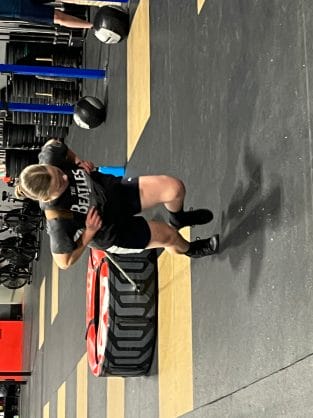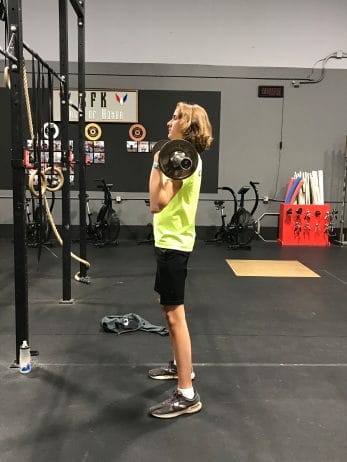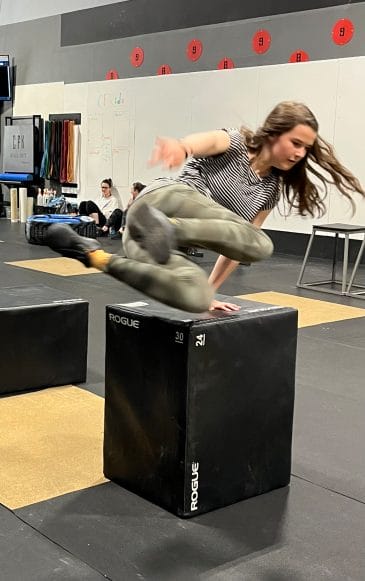By Jenn Casey, Youth Program Director
This week, our spotlight is on our Varsity level classes, for teens 13-19. Our program might be their primary fitness activity or they could be involved in other sports and activities.
In our Varsity Youth Program, kids are exposed to all types of fundamental movements in fun ways, with positive knowledgable staff whose primary goal is to help foster a love of movement while keeping kids safe and injury-free through these critical stages of development.
Kids in Varsity classes are ready for more movement challenges and goal-setting. We talk a lot about the effects of exercise on their bodies, and how their (sometimes very quickly!) growing bodies react to different types of movement.
Kids learn how and when to make adjustments to their workouts, become competent in movement skills (such as where to put their feet, how to engage core or shoulders), and begin to learn how to design their own workouts.

What kinds of things do the Varsity kids do in class?
All humans need to use and practice the six “primal movements.” These are: Squat, Push, Pull, Lunge, Hinge, and Core.
We review and practice these movements in every class. Teens are usually ready for a bit of load. They learn the basics of using kettlebells, dumbbells, and barbells. How we (primarily the coach) choose loads and progress the loads differs a bit from how we do this in our adult classes. Teens are going through physical, emotional, and mental developments which need to be considered.
The Brand X Method uses the “biopsychosocial” model of fitness for youth:
Kids should work out because it encourages, supports, and helps sustain good physical and mental health.
As it develops, the human body needs movement to properly make use of natural physiological, as well as psychological and social development milestones in the most optimal way.
There is an abundance of research out there identifying the benefits of physical activity for various aspects of our well-being: brain function, cardiorespiratory health, lymphatic system, mental health, etc.
https://thebrandxmethod.com/
In other words, fitness should and can benefit the WHOLE child: physically, mentally (emotionally), and psychologically. And given that youth are in a state of constant change, the fitness programs and sports they are involved in should not only be aware of these stages of development, the coaches should be knowledgable about how to best work with each kid at each stage of development, to help them keep moving, safely, with long-term goals in mind.

Physical Development
Practice is vital for habit development. And for kids whose bodies are changing seemingly overnight, practice serves an additional purpose. After each growth spurt, an adolescent youth needs to re-learn how to use her body in space. Her arms and legs are longer, so she might need to adjust her stance for a squat or a deadlift or a press. He might put on some weight, so he might be moving slower (and without judgment from anyone).
The long bones of the arms and legs grow before the bones of the torso and then the muscles, tendons, ligaments and nerves catch up.
https://performancemedicine.com.au/adolescent-growth-spurt-the-basics/
Any coach or trainer who works with youth should have knowledge about how adolescents are physically changing, and be able to make movement adjustments based on these changes. They should also be able to explain what’s happening to the kid, and be a supportive guide to him.
This is a huge reason why “range of motion” has a different application for the kids in our youth program. With our adults, whose bodies have finished developing, we work to create the greatest range of motion for any given movement, because that’s the best way to help keep adults moving well for the long term.
With youth, range of motion is very dependent on their physical limitations. When bones grow first, muscles are tight. A teen who could squat to depth last week might not be able to this week. They aren’t being lazy or sloppy; they are experiencing physical movement limitations, through no fault of their own. Trying to force a range of motion on this teen could injure him. Instead, we focus on “best range of motion today” and work to that standard in each class.

Psychological Development
The science behind how movement helps mental health is pretty well defined. I won’t talk too much about it here just now except to say that: A) Youth experience these mental and emotional health benefits, too, and B) with the pandemic, the need for mental health management is greater than it ever has been before.
Keeping kids moving is vital to their physical and mental health! Just last night, the teens in my Varsity class were all pretty tired. We are nearing the end of the school year, and we’re all kind of dragging. I changed our planned workout and made it into a team workout so they could rest while the partner worked, and told them to have a Joy of Movement day.
What’s a Joy of Movement Day? Drop everything: load, intensity, reps, to about two-thirds to half of what you’d normally do, put on some fun music, and get that heart rate up!
They all agreed they felt better for having come to class. That’s a big WIN.

Social Development
The teen years are a critical time in social development, where kids are shifting social connections away from their primary family and toward friends. They begin to form and solidify a self-identity, and experiment with identities (for example: my hair in the 1980s was definitely experimental!). Teens may also look to other trusted adults for guidance and advice.
While I love it when families work out together at our gym, I will always make sure we offer youth-only classes. In our youth program, kids have the whole space to themselves, with the guidance of a trusted adult. They can share jokes and camaraderie and the fun/misery of working out together. The vibe (as my teens would call it) is different, unique, and special. It’s different from the vibe in the adult classes, and that’s important. Kids can be themselves, silly, serious, tired, or energetic.
This isn’t to say a teen can’t get something out of a class taken with adults. However, youth-only classes offer them more. Youth-only classes offer chances to make social connections with peers, to learn how to lead and follow, to challenge themselves and each other. To use slang that nobody else can understand. Dank, right? (I don’t know what that means LOL)
Additionally, not all coaches are knowledgable about the complexities that come with working with youth at all ages. Kids will do better with coaches who can understand what to expect. A good coach educates and guides the teen, helping them understand why they might need to go lighter than usual tonight. Teens need coaches who explain things patiently, and often repeatedly. A coach who understands that sometimes a teen doesn’t understand their emotions and is supportive when they are having an off night.
Our Varsity classes offer teens opportunities to make social connections, learn more deeply about how movement affects their growing bodies, supports their emotional and mental health, and helps them move safely without injury during physical growth spurts.
Currently, our Varsity classes meet on Tuesdays and Thursdays at 7:30pm. We’re putting together other offerings for the summer, too!
